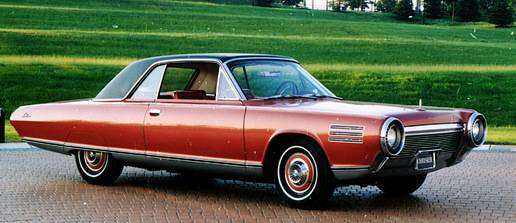 上世纪60年代,克莱斯勒等一众汽车厂商曾斥资数百万美元,为汽车和卡车研制燃气轮机发动机。(图片来源:菲亚特克莱斯勒)
上世纪60年代,克莱斯勒等一众汽车厂商曾斥资数百万美元,为汽车和卡车研制燃气轮机发动机。(图片来源:菲亚特克莱斯勒) 上世纪50年代后期的产品规划风格。福特曾计划推出一款神奇的未来核动力汽车Nucleon,还曾计划在几年后推出一款下置发动机(发动机置于驾驶室下方)的皮卡。
上世纪50年代后期的产品规划风格。福特曾计划推出一款神奇的未来核动力汽车Nucleon,还曾计划在几年后推出一款下置发动机(发动机置于驾驶室下方)的皮卡。 毕马威汽车业务英国总监John Leech相信,英国的环境特别适合率先开始采用自动驾驶汽车服务。
毕马威汽车业务英国总监John Leech相信,英国的环境特别适合率先开始采用自动驾驶汽车服务。 里卡多的Neville Jackson教授表示,“我认为产品规划一直是汽车行业所面临的关键挑战。”
里卡多的Neville Jackson教授表示,“我认为产品规划一直是汽车行业所面临的关键挑战。”
产品规划师语录:“你们的‘雷达’技术准确度如何,足以帮助车辆实现2020年的自动驾驶目标吗?还是只是让公司白花钱而已?”
回顾过去,车辆工程的历史中充满了各种对未来技术趋势的错误解读,以及不计其数“最终被砍掉”的项目。其中,未来的动力系统和燃料应用是最难预测的。上世纪60年代,在燃气轮机汽车技术的竞赛中,克莱斯勒(Chrysler)曾打造了55款燃气轮机,其中一款还可使用多种燃料,包括龙舌兰酒。那时,一大批卡车制造商也跟着走上了燃气轮机的道路,但最终都扑了一场空。
30年多年来,至少有十多家厂商投资在汪克尔(Wankel)转子发动机的许可证和原型车上,共计花费了数十亿美元。1958年,福特汽车(Ford)甚至曾满脑子想着利用微型核反应堆给汽车供电,并真的着手开始打造一款3/8比例的福特“Nucleon”核动力汽车原型。
上世纪50年代后期的产品规划风格。福特曾计划推出一款神奇的未来核动力汽车Nucleon,还曾计划在几年后推出一款下置发动机(发动机置于驾驶室下方)的皮卡。
里卡多(Ricardo)公司的首席技术创新官Neville Jackson教授指出,如今,准确预测新技术的成熟程度,并判断该技术是否真的做好了量产准备,这其中的风险比过去更高。
“产品规划一直是汽车行业所面临的关键挑战。”Jackson告诉《汽车工程》,“考虑到如今包括动力系统技术在内的产品选择不断丰富,汽车厂商的产品规划需要经过更严格管理,不仅要针对某款具体车型,更要着眼于公司的生产制造灵活度,从而通过合理的规划让不同的汽车能够实现跨平台的协同效应。”
Johnson认为,汽车的整个设计、工程和制造系统需要紧密结合整个产品可选范围进行选择。他警告说,汽车厂商不能指望各种技术“面面俱到”,因为这种战略的成本过于高昂。Johnson表示,“最困难的就是做出取舍。”
毕马威汽车业务英国总监John Leech相信,英国的环境特别适合率先开始采用自动驾驶汽车服务。
互联汽车的收益如何?
最近,行业咨询公司毕马威(KPMG)出版的《全球汽车行业高管意见调查(2017版)》(Global Automotive Executive Survey 2017)强调了移动出行领域产品规划师所面临的挑战。这份去年秋天开展的网络调查结果显示,大约有74%的英国汽车高管预测,大约有50%的车主表示,在未来十年内将不再愿意自己购置汽车,自动驾驶技术和交通出行服务将成为他们的优先选择。
“未来,汽车制造商的成绩将不再单单取决于售出车辆的数量,而是在完整车辆使用周期中为客户创造的总价值,特别是在数字生态系统已经做好准备,将要大举进入市场的大环境下。”毕马威汽车业务主管John Leech认为,“汽车厂商必须开始思考。”他还指出,超过75%的受访者均认为,1辆互联汽车在完整使用周期中创造的价值相当于10辆非互联汽车。
毕马威公司推断,消费者需求从“汽车购买”向“汽车使用”转移可能会降低市场对车辆的需求,因此,未来几年内,厂商制造汽车的利润将有所降低。但调查显示,绝大多数汽车行业高管对此并不感到担心:85%的受访者表示,他们确信,汽车厂商可以通过提供新型数字服务,创造比之前仅出售汽车更高的利润。
里卡多公司的Jackson指出,虽然自动汽车技术正在飞速发展,“但(SAE)4级和5级自动驾驶的真正到来,还需要克服众多技术、运营和安全方面的挑战。”他解释道,“一旦能够解决这些问题,自动驾驶汽车对最终用户的吸引力将是毋庸置疑的。”
Jackson补充说,目前,行业需要面临的问题之一在于多数汽车的利用率“非常低”,估计很多车辆的利用率还不到5%。
Jackson猜测,“随着车辆的技术含量和内含价值逐步增加,一种采用‘按次付费’或‘共享使用’模式的,基于服务的汽车运行模式可能会应运而生。”他补充说,这种模式可能会大大降低汽车单位里程的使用成本,转型将势在必行。
毕马威的Leech认为,英国的环境特别适宜率先开始采用Jackson口中的“服务型”汽车模式。英国政府的“绿带”政策创造了一个相对密集的城市人口环境,这里的燃料成本很高。这意味着,SAE 5级自动驾驶出租车能够为英国民众节省的交通支出将高于欧洲和北美市场。
Leech表示,“我相信,机器人出租车将在未来5到10年内彻底改变英国的城市交通面貌。”
里卡多的Neville Jackson教授表示,“我认为产品规划一直是汽车行业所面临的关键挑战。”
柴油车技术将何去何从?
毕马威的调查还发现,62%的汽车高管认为柴油车技术已经是“过去时”了。由于全球对CO2和NOx排放的关切不断增加,未来这种“传统”动力汽车将逐步从汽车厂商的产品目录中消失。
里卡多的Johnson则表示,柴油动力系统在乘用车领域的能效优势将长期存在,“离过时还早着呢。”但他的确怀疑柴油动力系统的能效优势能否足以支持这种燃料技术的研发、实施成本,特别是在柴油技术多用于非豪华车型的情况下。
“柴油动力系统将会面临一些不利影响,部分城市计划禁止柴油车的使用,这无疑会打消用户购买柴油车的想法,尽管这些政策可能主要针对的仅仅是一些老旧的车型。”Johnson指出,“考虑到这些原因,我们几乎可以肯定,未来柴油乘用车的市场份额将随着时间推移逐步缩小。不过,对于大巴和卡车等在治理措施出台后更容易实现改造的重型车辆而言,情况就不一样了,这类车型可选的燃料动力技术非常有限,甚至可以说根本没有其他选择。”
毕马威还有一个出人意料的发现:93%受访高管所在的公司,均有计划在未来5年中投资纯电动汽车。事实上,他们预测,纯电动汽车将在2025年之前统治全球汽车市场。
Product planners: How accurate is your technology ‘radar?’ Will the feature content you’ve bet on for 2020 be a hit—or a costly miss—in the marketplace?
Vehicle engineering history is littered with misread technology trends and cancelled development programs. Future powertrains and fuels have been the trickiest. Pursuing gas-turbine power for cars in the 1960s, Chrysler built 55 units including one that demonstrated its multi-fuel capability by running on tequila. A number of truckmakers also followed the turbine route without payoff.
At least a dozen OEMs collectively spent billions on Wankel rotary-engine licenses and prototypes over three decades. And Ford even flirted with the idea of micro nuclear reactors, working up its 3/8-scale “Nucleon” concept in 1958.
Predicting the status of a new technology and deciding if and when to commit to its production is riskier than ever before, noted Prof. Neville Jackson, Ricardo’s Chief Technology and Innovation Officer.
“Product planning always has been a crucial challenge for the industry," he told Automotive Engineering. "The increasing diversity of product offerings, including different powertrain technologies, requires very careful management not just of the product planning process for each individual model, but of the manufacturing flexibilities required to leverage cross-platform synergies."
Jackson believes the entire automotive design, engineering and manufacturing sysem needs to be far better integrated across the entire product range. He cautioned that it will be too expensive to cover all of the technology options available. "The most difficult task will be to pick the winners,” he said.
Connected-car profits
The recently published Global Automotive Executive Survey 2017 by KPMG, an advisory services company, highlights the challenges facing mobility-industry product planners. The online survey conducted last fall found that some 74% of U.K. automotive executives expect more than half of today’s car owners will not want to own a car within ten years. Self-driving technology and mobility as a service will take priority.
“Carmakers’ success will not be evaluated solely on the quantity of vehicles sold, but on the customer value over the whole lifecycle—especially when the digital ecosystem will be ready for the market," observed John Leech, KPMG's Automotive lead in the U.K. "OEMs need to rethink," he said, noting that over 75% of those surveyed believe that one connected car can generate higher revenues over its life cycle than 10 non-connected cars.
KPMG deduced that the impact of consumers shifting away from an ownership model to a vehicle-use model will reduce demand for fewer cars and therefore reduced profits from building vehicles in the future. But the survey showed that this does not worry the majority of automotive execs: 85% of the respondents said they are convinced that their company will generate higher revenues by providing new digital services, than by selling cars alone.
Ricardo's Jackson noted that while the development of autonomous vehicle technology is clearly continuing apace, "there remain many technical, operational and safety challenges to be overcome in implementing [SAE] Level 4 or 5 solutions," he explained. "Once these are overcome, the attractions are obvious to the end user.”
He added that a further impetus is the currently “very poor” asset utilization of vehicles, estimated by many as less than 5%.
“As the technology content and embedded value of vehicles increases, an increasingly servitized model of vehicle use may well emerge, based on pay-per-use or even shared usage," Jackson surmises. He added that while this is likely to substantially reduce the cost/mile for vehicle use, the transition will occur gradually.
KPMG's Leech believes the U.K. is particularly suited to the early adoption of Jackson's "servitized" model. The government's greenbelt policy has created a relatively dense urban population which, when coupled with high fuel prices, means that SAE Level 5 taxis offer a greater cost saving to the U.K. public, compared to European or North American markets.
"I believe robot taxis will revolutionize U.K. urban transportation in the second half of the next decade,” Leech said.
Diesel's future?
The survey also found that 62% of the automotive executives regard diesel technology as passé. It concluded that "traditional" powertrain technology will eventually vanish from manufacturers’ portfolios due to increasing concern over CO2 and NOx emissions.
Ricardo's Jackson is pragmatic about diesel's long term future for passenger cars, calling the combustion technology " far from passé." But he questioned whether the price of development and implementation still provides an attractive commercial case within the market, particularly for non-premium products.
"The negative effects of the plans by some city authorities to penalize the use of diesel, may well dissuade customers from selecting diesel even if such measures are aimed primarily at the legacy fleet," Jackson noted. "For these reasons it is almost certain, that the diesel share of the passenger car market will reduce over time. This is not the case, however, for heavy duty vehicles such as buses and trucks, which are more amenable to retrofit after treatment measures aimed at existing fleets and where there are few if any alternative powertrain technologies available.”
One surprise from the KPMG findings: 93% of executives surveyed are planning for their companies to invest in technology for battery electric vehicles over the next five years. In fact they expect BEVs to dominate the automotive market by 2025.
Author: Stuart Birch
Source: SAE Automotive Engineering Magazine
等级
打分
- 2分
- 4分
- 6分
- 8分
- 10分
平均分
- 作者:Stuart Birch
- 行业:汽车
- 主题:管理与产品开发
